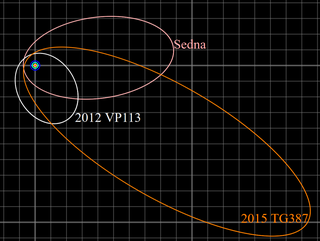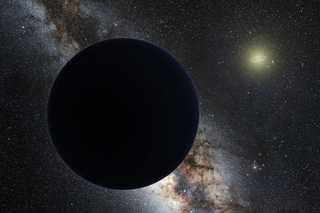
A classical Kuiper belt object, also called a cubewano ( "QB1-o"), is a low-eccentricity Kuiper belt object (KBO) that orbits beyond Neptune and is not controlled by an orbital resonance with Neptune. Cubewanos have orbits with semi-major axes in the 40–50 AU range and, unlike Pluto, do not cross Neptune's orbit. That is, they have low-eccentricity and sometimes low-inclination orbits like the classical planets.

Following the discovery of the planet Neptune in 1846, there was considerable speculation that another planet might exist beyond its orbit. The search began in the mid-19th century and continued at the start of the 20th with Percival Lowell's quest for Planet X. Lowell proposed the Planet X hypothesis to explain apparent discrepancies in the orbits of the giant planets, particularly Uranus and Neptune, speculating that the gravity of a large unseen ninth planet could have perturbed Uranus enough to account for the irregularities.
In astronomy, the plutinos are a dynamical group of trans-Neptunian objects that orbit in 2:3 mean-motion resonance with Neptune. This means that for every two orbits a plutino makes, Neptune orbits three times. The dwarf planet Pluto is the largest member as well as the namesake of this group. The next largest members are Orcus, (208996) 2003 AZ84, and Ixion. Plutinos are named after mythological creatures associated with the underworld.

A trans-Neptunian object (TNO), also written transneptunian object, is any minor planet in the Solar System that orbits the Sun at a greater average distance than Neptune, which has an orbital semi-major axis of 30.1 astronomical units (au).

Sedna is a dwarf planet in the outermost reaches of the Solar System discovered in 2003. Spectroscopy has revealed that Sedna's surface composition is largely a mixture of water, methane, and nitrogen ices with tholins, similar to those of some other trans-Neptunian objects. Its surface is one of the reddest among Solar System objects. Sedna, within estimated uncertainties, is tied with Ceres as the largest planetoid not known to have a moon. It has a diameter of approximately 1,000 km ; its mass is unknown.

The scattered disc (or scattered disk) is a distant circumstellar disc in the Solar System that is sparsely populated by icy small Solar System bodies, which are a subset of the broader family of trans-Neptunian objects. The scattered-disc objects (SDOs) have orbital eccentricities ranging as high as 0.8, inclinations as high as 40°, and perihelia greater than 30 astronomical units (4.5×109 km; 2.8×109 mi). These extreme orbits are thought to be the result of gravitational "scattering" by the gas giants, and the objects continue to be subject to perturbation by the planet Neptune.
474640 Alicanto, provisionally designated 2004 VN112, is a detached extreme trans-Neptunian object. It was discovered on 6 November 2004, by American astronomer Andrew C. Becker at Cerro Tololo Inter-American Observatory in Chile. It never gets closer than 47 AU from the Sun (near the outer edge of the main Kuiper belt) and averages more than 300 AU from the Sun. Its large eccentricity strongly suggests that it was gravitationally scattered onto its current orbit. Because it is, like all detached objects, outside the current gravitational influence of Neptune, how it came to have this orbit cannot yet be explained. It was named after Alicanto, a nocturnal bird in Chilean mythology.

2012 VP113, also known by its nickname "Biden", is a trans-Neptunian object of the sednoid population, located in the outermost reaches of the Solar System. It was first observed on 5 November 2012 by American astronomers Scott Sheppard and Chad Trujillo at the Cerro Tololo Inter-American Observatory in Chile. The discovery was announced on 26 March 2014. The object probably measures somewhere between 300 and 1000 km in diameter, possibly large enough to be a dwarf planet.

A sednoid is a trans-Neptunian object with a perihelion well beyond the Kuiper cliff at 47.8 AU. Only four objects are known from this population: 90377 Sedna, 2012 VP113, 541132 Leleākūhonua (2015 TG387), and 2021 RR205, but it is suspected that there are many more. All four have perihelia greater than 55 AU. These objects lie outside an apparently nearly empty gap in the Solar System and have no significant interaction with the planets. They are usually grouped with the detached objects. Some astronomers consider the sednoids to be inner Oort cloud objects (OCOs), though the inner Oort cloud, or Hills cloud, was originally predicted to lie beyond 2,000 AU, beyond the aphelia of the four known sednoids.

An extreme trans-Neptunian object (ETNO) is a trans-Neptunian object orbiting the Sun well beyond Neptune (30 AU) in the outermost region of the Solar System. An ETNO has a large semi-major axis of at least 150–250 AU. Its orbit is much less affected by the known giant planets than all other known trans-Neptunian objects. They may, however, be influenced by gravitational interactions with a hypothetical Planet Nine, shepherding these objects into similar types of orbits. The known ETNOs exhibit a highly statistically significant asymmetry between the distributions of object pairs with small ascending and descending nodal distances that might be indicative of a response to external perturbations.

Planet Nine is a hypothetical ninth planet in the outer region of the Solar System. Its gravitational effects could explain the peculiar clustering of orbits for a group of extreme trans-Neptunian objects (ETNOs), bodies beyond Neptune that orbit the Sun at distances averaging more than 250 times that of the Earth. These ETNOs tend to make their closest approaches to the Sun in one sector, and their orbits are similarly tilted. These alignments suggest that an undiscovered planet may be shepherding the orbits of the most distant known Solar System objects. Nonetheless, some astronomers question this conclusion and instead assert that the clustering of the ETNOs' orbits is due to observational biases, resulting from the difficulty of discovering and tracking these objects during much of the year.
(533560) 2014 JM80, provisional designation 2014 JM80, is a trans-Neptunian object from the scattered disc in the outermost Solar System, approximately 340 kilometers (210 miles) in diameter. It was discovered on 9 May 2010 by astronomers with the Pan-STARRS-1 survey at the Haleakala Observatory, Hawaii, in the United States. According to American astronomer Michael Brown, it is "possibly" a dwarf planet.
2014 FZ71 is a trans-Neptunian object, a scattered disc classified as a scattered and detached object, located in the outermost region of the Solar System. It was first observed on 24 March 2014, by a team led by American astronomer Scott Sheppard at the Cerro Tololo Inter-American Observatory in Chile. With its perihelion of almost 56 AU, it belongs to a small and poorly understood group of very distant objects with moderate eccentricities. The object is not a dwarf planet candidate as it only measures approximately 150 kilometers (93 miles) in diameter.
2014 FC72 is a trans-Neptunian object, classified as a scattered and detached object, located in the outermost region of the Solar System. It was first observed on 24 March 2014 by astronomers with the Pan-STARRS survey at Haleakala Observatory, Hawaii, United States. With its perihelion distant from Neptune, it belongs to a small and poorly understood group of objects with moderate eccentricities. It is estimated to measure 500 kilometers (300 miles) in diameter, assuming a low albedo.
2015 FJ345 is a trans-Neptunian object and detached object, located in the scattered disc, the outermost region of the Solar System. It was first observed on 17 March 2015, by a team led by American astronomer Scott Sheppard at the Mauna Kea Observatories, in Hawaii, United States. With its perihelion of almost 51 AU, it belongs to a small and poorly understood group of very distant objects with moderate eccentricities. The object is not a dwarf planet candidate as it only measures approximately 120 kilometers (75 miles) in diameter.
2015 KQ174 is a trans-Neptunian object, both considered a scattered and detached object, located in the outermost region of the Solar System. The object with a moderately inclined and eccentric orbit measures approximately 154 kilometers (96 miles) in diameter. It was first observed on 24 May 2015, by astronomers at the Mauna Kea Observatories in Hawaii, United States.
The hypothetical Planet Nine would modify the orbits of extreme trans-Neptunian objects via a combination of effects. On very long timescales exchanges of angular momentum with Planet Nine cause the perihelia of anti-aligned objects to rise until their precession reverses direction, maintaining their anti-alignment, and later fall, returning them to their original orbits. On shorter timescales mean-motion resonances with Planet Nine provides phase protection, which stabilizes their orbits by slightly altering the objects' semi-major axes, keeping their orbits synchronized with Planet Nine's and preventing close approaches. The inclination of Planet Nine's orbit weakens this protection, resulting in a chaotic variation of semi-major axes as objects hop between resonances. The orbital poles of the objects circle that of the Solar System's Laplace plane, which at large semi-major axes is warped toward the plane of Planet Nine's orbit, causing their poles to be clustered toward one side.
2014 ST373 (prov. designation:2014 ST373) is a trans-Neptunian object and a detached object from the outermost region of the Solar System. With a perihelion of 50.2 AU, it belongs to the top 10 minor planets with the highest known perihelia of the Solar System. and is neither a scattered disc nor an extreme trans-Neptunian object. It measures approximately 370 kilometers (230 miles) in diameter and was first observed on 25 September 2014, by astronomers using the Dark Energy Camera (DECam) at Cerro Tololo Inter-American Observatory in Chile.












